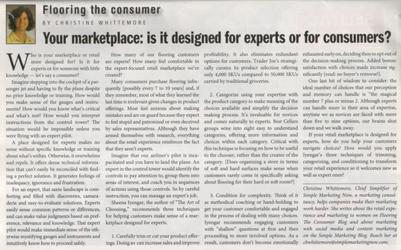
Your marketplace: is it designed for experts or for consumers?
By Christine B. Whittemore
“Today's marketplace is designed for experts, but we aren't all experts.”
Sheena Iyengar, author The Art of Choosing
BRITE ’11 Conference
Who is your marketplace or retail store designed for? Is it for experts or for someone with little knowledge – let’s say a consumer?
Imagine stepping into the cockpit of a passenger jet and having to fly the plane despite no prior knowledge or training. How would you make sense of the gauges and instruments? How would you know what’s critical and what’s not? How would you interpret instructions from the control tower? The situation would be impossible unless you were flying with an expert pilot.
A place designed for experts makes no sense without specific knowledge or training about what’s within. Otherwise, it overwhelms and repels. It offers dense technical information that can’t easily be reconciled with finding a perfect solution. It generates feelings of inadequacy, ignorance and frustration.
For an expert, that same landscape is comforting and filled with discoveries, camaraderie and easy-to-evaluate solutions. Experts easily sense common patterns or differences, and can make value judgments based on preference, relevance and knowledge. That expert pilot would make immediate sense of the otherwise mystifying gauges and instruments and intuitively know how to proceed safely.
How many of our flooring customers are experts? How many feel comfortable in the expert-focused retail marketplace we’ve created?
Many consumers purchase flooring infrequently [possibly every 7 to 10 years] and, if they remember, most of what they learned the last time is irrelevant given changes in product offerings. Most feel anxious about making mistakes and are on guard because they expect to feel stupid and patronized or even deceived by sales representatives. Although they have armed themselves with research, everything about the retail experience reinforces the fact that they aren’t experts.
Imagine that our airliner’s pilot is incapacitated and you have to land the plane. An expert in the control tower would identify the controls to pay attention to, group them into areas of interest, and coach you in sequences of actions using those controls. So by careful instruction, you can manage an expert’s job.
Similarly, Sheena Iyengar, whom I quote above, recommends three techniques for helping customers make sense of a marketplace designed for experts.
1. Carefully trim or cut your product offerings. Doing so carefully can increase sales and improve profitability. It also eliminates redundant options for customers. Trader Joe’s strategically curates its product selection offering only 4,000 SKUs compared to 50,000 SKUs carried by traditional groceries.
2. Categorize using your expertise with the product category to make meaning of the choices available and simplify the decision making process. It’s invaluable for novices and comes naturally to experts. Best Cellars groups wine into 8 easy to understand categories, offering more information and choices within each category. Critical with this technique is focusing on how to be useful to the chooser, rather than the creator of the category. [Does organizing a store in terms of soft and hard surfaces make sense when customers rarely come in specifically asking about flooring for their hard or soft room?]
3. Condition for complexity. Think of it as methodical coaching or hand-holding to get your customer comfortable and engaged in the process of dealing with many choices. Iyengar recommends engaging customers with ‘shallow’ questions at first and then proceeding to more involved options. As a result, customers don’t become emotionally exhausted early on, deciding then to opt out of the decision-making process. Added bonus: satisfaction with choices made increase significantly [read: no buyer’s remorse!].
One last bit of wisdom to consider: the ideal number of choices that our perception and memory can handle is “the magical number 7 plus or minus 2”. Although experts can handle more in their area of expertise, anytime we as novices are faced with more than 5 to 9 options, our brains shut down and we walk away.
If your retail marketplace is designed for experts, how do you help your customers navigate choices? How would you apply Iyengar’s three techniques of trimming, categorizing, and conditioning to transform your retail experience so it welcomes new customers as well as expert ones?
Remember, your goal is to land the plane, not crash it.







